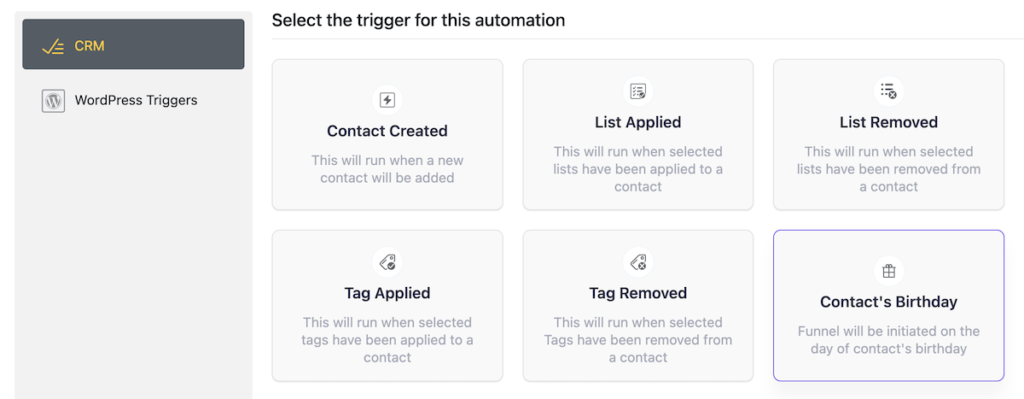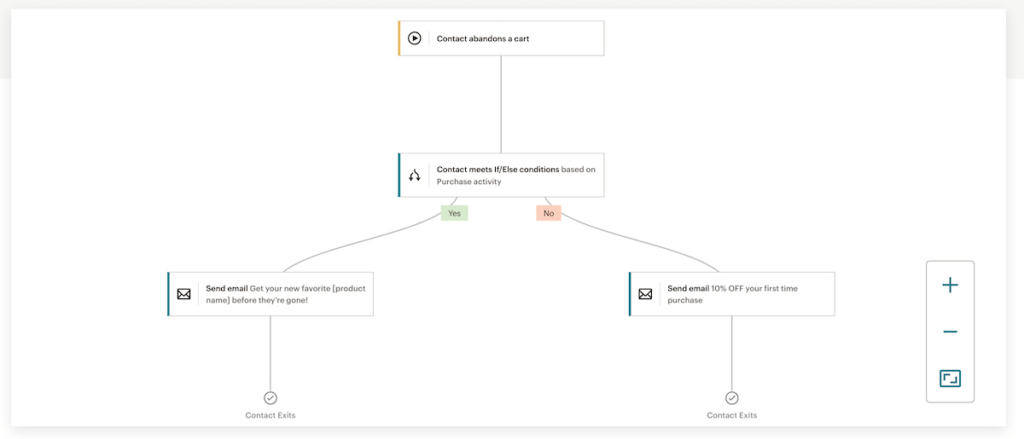
Table of Contents
FluentCRM, MailPoet, and MailChimp are all popular email marketing systems. But how can you decide which tool is appropriate for your site? Every WordPress site is unique, as are your emailing needs. Learn what distinguishes each tool so you can select the best alternative for your website and budget.
Trying to decide whether FluentCRM, MailPoet, or MailChimp is the best email marketing software for your WordPress website?
All three technologies enable you to send emails to your contacts to grow your business and build stronger relationships. Because email has the highest ROI of any marketing medium, you want to be sure you select the tool that best fits your budget and objectives.
In this article, we’ll explore the main features of each tool, as well as a price breakdown.
Crucial Plugin Features of MailPoet, MailChimp, and FluentCRM
To begin this comparison of FluentCRM, MailPoet, and MailChimp, let’s take a closer look at some of the key attributes of each email marketing platform. You can discover what makes each of these tools unique down below.
MailPoet

MailPoet is a WordPress plugin that allows you to easily send email newsletters. It allows you to create and send both manual and automatic emails directly from your WordPress dashboard. The plugin’s main purpose is to allow you to send email newsletters. However, it can generate welcome emails and other automated email campaigns.
Features
MailPoet is easy to use and includes a variety of tools for creating email newsletters. You’ll find over 50 customizable drag-and-drop templates.
Email newsletters can be delivered automatically or manually.
Other sequences you can make include emails that automatically notify readers of new blog posts when you write one, or welcome sequences.
You can use a few different email kinds if you have a WooCommerce store, such as:
- E-mails about shopping cart abandonment
- Initial purchase emails
- Purchase emails for products (for a product or category)
Usability
MailPoet is quite easy to use. All you have to do is install the plugin—it was designed just for WordPress—and the setup wizard will guide you through configuring the plugin and sending your first email.
With the aid of the user-friendly plugin and its assortment of templates, you can easily construct email campaigns.
Nevertheless, it has occasionally been glitchy, and the transmitting service is problematic.
Integrations are key
MailPoet provides more than 29 distinct integrations in total. It makes it natural that the majority of these integrations are with WordPress form plugins and other lead-generation tools, as sending emails requires generating leads. Formidable Forms, FluentForms, OptinMonster, Elementor, and more are some of these plugins.
Apart from optin and lead generation plugins, not many additional plugins are supported. Integrations with well-known plugins like MemberPress and WooCommerce are available, nevertheless.
FluentCRM

With the help of the email marketing automation plugin FluentCRM, your WordPress website can now have extensive email functionality and CRM features. It is capable of generating leads, managing contacts in-depth, sending simple emails, segmenting leads, constructing sophisticated email automation, and much more.
Features
With its abundance of capabilities, FluentCRM functions as both a stand-alone CRM and a powerful email marketing tool. This application lets you make drip sequences, email marketing automation, and deliver manual or automated email campaigns.
Similar to the other two tools, you can send email campaigns to your contact list. Nevertheless, you can also choose to perform various post-campaign activities and split-test your emails.
You can design many emails that are sent out based on particular actions or deadlines using email sequences. These function optimally within an automated funnel. You can include a post-purchase upsell sequence, a welcome sequence, and other features to attract new members.
A plethora of automation tools are also provided by FluentCRM. The automation tools are sophisticated, but they’re still quite user-friendly for beginners.
Automation setup doesn’t require any further configuration. FluentCRM detects the plugins you have installed on your website and will then suggest triggers based on them. One of these actions by a user will start the automation you set up.
The following are examples of some of these triggers:

You can decide on many steps for your subscribers to take after that first trigger. The best part is that you can run more than one automation at once. There are other types of sequences that you can have, such as welcome, launch, post-purchase, abandoned cart, and more.
These visual workflows for automation will allow you to quickly add new emails and alter your user journey.
You can design conditionally-based automated email campaigns to provide an even more personalized experience. Alternatively, you might use A/B email campaigns to gradually increase conversions.
Lastly, there are built-in dynamic segments and tags that you can use to deliver subscriber-specific email campaigns or start new email automation.
Compared to other tools, the automation functions are extremely sophisticated and user-friendly.
Usability
Installing FluentCRM is as simple as starting to create email marketing automation because it is a WordPress plugin. Fluent Forms, which enables you to add sign-up forms to your website, is also added during plugin installation.
Its automatic integration with other WordPress plugins is one of its best features. So, setting up intricate integrations is not necessary.
The plugins you are using will be immediately detected by FluentCRM, which will then display your accessible automation.
For instance, you’ll see the possible membership email automation immediately if Paid Memberships Pro is loaded. The same holds for those who use WooCommerce to run online stores.
Setting up email sending is the largest configuration you’ll need to accomplish with FluentCRM.
You will experience problems with email deliverability if you send emails using WordPress. Alternatively, you can send emails using an inexpensive service like SendGrid, Mailgun, or Amazon SES.
Integrations are key
More than 25 distinct popular WordPress tools and plugins are integrated with FluentCRM. The most popular connectors are Easy Digital Downloads, MemberPress, WooCommerce, Elementor, LearnDash, and more.
The most advantageous aspect of utilizing FluentCRM in conjunction with other plugins is its ability to automatically identify the plugins you have installed and present to you the most effective ways to utilize the integration. No intricate setup or configuration is necessary.
Nevertheless, as of right now, not many forms- or lead-generating plugins are integrated with the plugin.
Fluent Forms connects with it with ease, however, at this time, support for other well-known plugins is lacking. Webhooks are one way to get around this, but some WordPress users might find this to be too complex.
MailChimp

A powerful and well-liked email marketing tool is MailChimp. It allows you to segment your list, make sophisticated automation, and send email newsletters, among other things. Along with a ton of features, it has several integrations. To use it with your WordPress website, though, you’ll need to integrate it correctly because it’s a third-party application.
Features
With over 100 email templates and an email builder, MailChimp makes it simple to personalize emails for yourself. You have the option to send scheduled emails, manual emails, or sophisticated automation, depending on the plan you’re using.
The manual email feature is akin to MailPoet and FluentCRM’s capabilities.
Its comprehensive campaign builder is the most helpful feature.
You may create intricate customer journeys with branching if/then logic using this tool. Because emails are closely linked to the behaviors of your customers, they will receive pertinent emails whenever they perform specific actions.
For your marketing objectives, there is a library of pre-built customer journeys available. This is how it appears:

Usability
Since it wasn’t designed with WordPress in mind, you’ll need to integrate the service with your website using a third-party MailChimp plugin like MC4WP. For everything to work correctly, you’ll also need to connect using your API key, validate your domain, and more. It’s not too hard, but for beginners, it can be a little complicated.
You will be able to send emails and manage your lists from your MailChimp account once you have integrated MailChimp functionality into your website.
Integrations are key
Almost 300 different plugins and tools are integrated with MailChimp overall. Given that it’s one of the most well-liked and extensively utilized email marketing systems available, this makes sense. There is likely a MailChimp integration available for whatever program you use.
Integrations with WooCommerce, MailOptin, FuseWP, and other platforms are available.
Having said that, just because an integration is widely available does not guarantee that it will function correctly or be simple to set up.
As is the case with most integrations, such as the WordPress to MailChimp integration, setting things up correctly takes a lot of time.
Price Comparison between MailPoet, FluentCRM, and MailChimp
When selecting the best email marketing platform for your requirements, price will be a major consideration beyond the feature set and learning curve. A thorough explanation of how these tools manage prices may be found below.
MailPoet Pricing
For up to 1,000 contacts, MailPoet is free if you have the Starter plan. You can only send 5,000 emails in a month, though.
Subscription forms, rudimentary automation, and an email analytics summary are all included in this package. MailPoet is used for all sending.
The 1,000 subscriber barrier must be met before you may upgrade to the Business or Agency plan. As the number of subscribers rises, the cost of these will also rise. On the other hand, you also get limitless email sending, segmentation, marketing automation, and comprehensive email statistics.

Pricing for FluentCRM
FluentCRM offers extremely clear pricing in contrast to other SaaS products and WordPress plugins. It is based on straightforward annual pricing, which is a big plus for agencies and medium-sized companies.
The number of sites you’ll need to support will be the primary distinction between each pricing tier.
The Solo Entrepreneur plan, which begins at $129 annually, is currently the most economical option. As you can see from the screenshot below, it is occasionally discounted, so be sure to keep an eye out for any deals.
A summary of the premium plans as of March 2024 is provided below:

You should also think about using an email service to deliver your emails. Numerous services exist, including SendGrid, Mailgun, and Amazon SES. The amount you pay will depend on how many emails you send. Every 1,000 emails you send will cost you $0.10 when using a provider like Amazon SES.
Ultimately, the plugin is available for free and has many of the same capabilities as the paid version. You may still send emails, set up automation, segment your list, and do other things, but the key distinction is that these features won’t be as comprehensive.
MailChimp Pricing
A 500-contact maximum free plan is available from MailChimp. You can send up to 1,000 emails a month with the free plan. You will, however, only have restricted access to the statistics and email template tools.
You must upgrade to one of MailChimp’s premium plans, which start at $13 a month for 500 contacts if you want to take advantage of all of its features.
The 1,000 subscriber barrier must be met before you may upgrade to the Business or Agency plan. As the number of subscribers rises, the cost of these will also rise. On the other hand, you also get limitless email sending, segmentation, marketing automation, and comprehensive email statistics.
You can access other features like email scheduling, A/B testing, and basic customer journeys with the Essentials plan. Comprehensive testing, sophisticated segmentation, and enhanced client journeys are all included in the standard plan. Similar to MailPoet, the plan’s cost will go up as your subscriber count does.
This monthly MailChimp plan, broken out based on 500 contacts, is as follows:

Take note of the steep price rises. For instance, the standard plan will cost you $100 per month if you have 5,000 contacts.
Which One Is The Best?
All three email marketing tools work together to complete the same job overall. To increase sales and strengthen your relationship, they enable you to send emails to a list of both new and current prospects and customers.
You can utilize MailPoet if all you’re trying to accomplish is sending a weekly email newsletter or other simple emails. It is straightforward, simple to use, and allows you to quickly establish basic automation and send emails.
However, FluentCRM will be your best bet if you need to build sophisticated automation or require detailed segmentation, reliable contact management, and much more. It is the most cost-effective choice, offers all the same capabilities, and is never restricted by the size of your contact list.
The lack of an email marketing template library is the sole feature missing from FluentCRM. But since you’ll be creating emails within a block editor, there are a lot of artistic possibilities available to you.
It is our earnest hope that this article has assisted you in selecting the ideal tool for your needs.